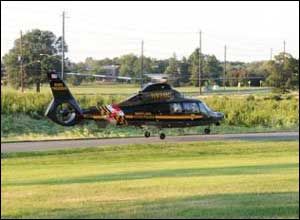Listen to the audio tapes of the Md. Medevac crash
By Robert Little
The Baltimore Sun
 AP Photo/Prince George’s County Fire Dept |
The emergency operator who dispatched a medevac helicopter to Waldorf on a mission that ended in a fatal crash told the pilot that ambulance crews called for the aircraft because they “never want to drive to the hospital.”
That, along with the revelation that the case was initially assigned an even lower medical priority than first reported, raises new questions about whether the flight was necessary — and whether Maryland and other states generally are using medical helicopters excessively. A report earlier this year found that nearly half the patients flown to hospitals in Maryland are discharged in less than a day, and the September crash was one of 26 fatal crashes of medical helicopters nationwide over the past six years.
On tapes of the conversations between dispatchers and emergency workers on the night of Sept. 28, a 911 operator in Waldorf describes the patients involved in an auto accident as being “Category D,” meaning that neither the patients nor their vehicle met the criteria for helicopter transport. Instead, both were being flown based on the judgment of emergency workers at the scene, though state officials say paramedics later assigned the patients a more urgent assessment.
When medevac pilot Stephen H. Bunker, who died in the crash, asked the State Police dispatcher where he was being asked to fly, the dispatcher replied, “Charles County. Waldorf. Where else? These guys never want to drive to the hospital.”
Later in the call the dispatcher says: “As soon as I heard Charles County, I knew it was going to be Waldorf. Because those guys never want to drive to the hospital.”
State officials released the tapes Thursday.
Dr. Robert R. Bass, executive director of the Maryland Institute for Emergency Medical Services Systems, said yesterday that officials reviewed records of Maryland’s medevac use after listening to the tape. He said they found that as a percentage of population each Southern Maryland county uses helicopters roughly the same amount — more than urban counties close to trauma centers, like Baltimore and Anne Arundel, but less than the most rural counties on the Eastern Shore, he said.
“We were disturbed” by the comments on the dispatch tape, Bass said. “But looking at the numbers, we can’t find any way to substantiate the belief that Charles County, or Waldorf, is an excessive user of helicopter transport.”
The director of fire and rescue services in Charles County also disputed the notion that ambulance crews in Waldorf are reluctant to drive long distances.
“That’s the whole purpose behind the protocols — to give that discretion to the providers at the scene,” said William Stephens, interim director of the Charles County Department of Emergency Services.
“I can say, unequivocally, that all providers in Charles County look first to the patient’s welfare, and default in favor of what’s best for the patient.”
State officials say they believe the Waldorf mission was medically appropriate based on Maryland’s trauma triage guidelines, which purposely err on the side of flying patients to catch injuries that are difficult to diagnose in the field.
The Waldorf car accident was 32 miles from the Princes George’s Hospital Center. Maryland’s triage protocols say emergency responders should consider calling a helicopter if the hospital is more than 30 minutes away by ground.
The trip would take 42 minutes in clear traffic, according to MapQuest, but a report from the National Transportation Safety Board said the helicopter waited at the accident scene for 30 minutes before departing with the patients onboard, crashing several minutes later. Bass said state officials had not determined why the helicopter spent a half-hour at the scene but that the wait was “longer than we typically like to see.”
In addition to assigning the lowest triage category to the patients, the Waldorf 911 dispatcher also referred to them in the recording as “priority 2,” which state guidelines define as a “less serious condition, requiring emergency medical attention but not immediately endangering the patient’s life.”
Bass said paramedics later assigned the patients a more urgent assessment, after deciding damage to their car might foreshadow hidden injuries.
“When things settle down emotionally, Maryland has really got to take a look at this more critically,” said Dr. Bryan E. Bledsoe, a critic of medevac transport and part of a seven-member panel that will meet Nov. 24 to explore Maryland’s trauma transportation network and recommend possible changes.
“It’s surprising an accident hasn’t happened before when you consider some of the things we’re starting to learn,” Bledsoe said.
Bunker, flight medic Mickey C. Lippy, ground medic Tonya Mallard and patient Ashley J. Younger died when the helicopter crashed in a wooded park a few miles from Andrews Air Force Base.
The question of when helicopters are appropriate has gained increasing attention in the medical community, as the number of fatal medevac crashes surged. A review by The Baltimore Sun of crash records and other documents related to the 26 most recent fatal accidents in the United States found that at least eight involved patients who waited longer for a helicopter than a ground ambulance might have needed to drive them to a hospital. At least six involved patients discharged soon after a helicopter dropped them off at a hospital, or who survived a lengthy ambulance ride after the helicopter sent to get them went down.











